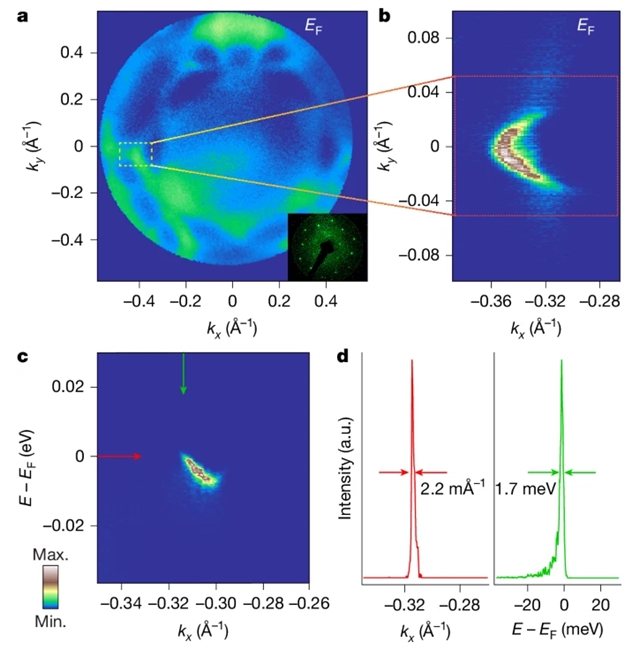PtBi2中的拓扑节点i波超导性

近日,德国莱布尼茨固态与材料研究所Jeroen van den Brink团队研究了PtBi2中的拓扑节点i波超导性。这一研究成果于2025年11月19日发表在《自然》杂志上。
大多数超导材料已被充分理解且属于常规类型——即通过电子对凝聚实现超导的电子对具有最高可能的对称性。著名的例外是神秘的高温铜基超导材料。其超导能隙中的节点是它们非常规特性的标志,意味着存在d波对称的超导配对。
研究组通过角分辨光电子能谱技术,观察到外尔半金属PtBi2的超导能隙中存在节点,这表明其具有非常规的i波配对对称性。在低于10开尔文的温度下,PtBi2的超导性使其拓扑表面态(费米弧)形成能隙,而体态仍保持正常态。研究组观测到的超导能隙节点恰好位于费米弧中心,这意味着在动量空间的该区域周围存在受拓扑保护的马约拉纳锥。由此研究组通过理论推断,在表面台阶边缘会出现稳健的零能马约拉纳平带。这一发现不仅确立了PtBi2表面是非常规的拓扑i波超导体,更为其作为实现马约拉纳束缚态制备与操控的理想材料平台奠定了基础。
附:英文原文
Title: Topological nodal i-wave superconductivity in PtBi2
Author: Changdar, Susmita, Suvorov, Oleksandr, Kuibarov, Andrii, Thirupathaiah, Setti, Shipunov, Grigory, Aswartham, Saicharan, Wurmehl, Sabine, Kovalchuk, Iryna, Koepernik, Klaus, Timm, Carsten, Bchner, Bernd, Fulga, Ion Cosma, Borisenko, Sergey, van den Brink, Jeroen
Issue&Volume: 2025-11-19
Abstract: Most superconducting materials are well understood and conventional—that is, the pairs of electrons that cause the superconductivity by their condensation have the highest possible symmetry. Famous exceptions are the enigmatic high-temperature (high-Tc) cuprate superconductors1. Nodes in their superconducting gap are the fingerprint of their unconventional character and imply superconducting pairing of d-wave symmetry. Here, by using angle-resolved photoemission spectroscopy, we observe that the Weyl semimetal PtBi2 harbours nodes in its superconducting gap, implying unconventional i-wave pairing symmetry. At temperatures below 10K, the superconductivity in PtBi2 gaps out its topological surface states, the Fermi arcs, whereas its bulk states remain normal2. The nodes in the superconducting gap that we observe are located exactly at the centre of the Fermi arcs and imply the presence of topologically protected Majorana cones around this locus in momentum space. From this, we infer theoretically that robust zero-energy Majorana flat bands emerge at surface step edges. This establishes PtBi2 surfaces not only as unconventional, topological i-wave superconductors but also as a promising material platform in the ongoing effort to generate and manipulate Majorana bound states.
DOI: 10.1038/s41586-025-09712-6
Source: https://www.nature.com/articles/s41586-025-09712-6



